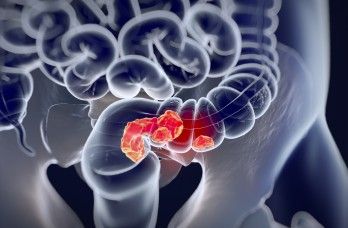MR-TRG Score May Measure Regression Magnitude in Rectal Adenocarcinoma
Investigators report that MRI by itself seems to be an inadequate tool for determining pathologic complete response in rectal adenocarcinoma during total neoadjuvant therapy.
"These findings present compelling data that should provide justification for using the MR-TRG to objectively describe regression more uniformly in patients with rectal adenocarcinoma undergoing [total neoadjuvant therapy]," according to the study authors.

MRI on its own did not appear sufficient for distinguishing pathologic complete response (pCR) in patients with rectal adenocarcinoma treated with total neoadjuvant therapy (TNT), although investigators indicated that magnetic resonance tumor regression grade (MR-TRG) was associated with magnitude of pathologic regression during treatment, according to findings from a substudy of the phase 2 NRG-GI002 trial (NCT02921256).
Investigators noted a relationship between MR-TRG scores and the presence of pCR (P <.01), as well as pathologic neoadjuvant response (NAR) score (P <.0001). The use of MR-TRG alone yielded a positive predictive value (PPV) of 40% (95% CI, 26%-53%) and a negative predictive value (NPV) of 84% (95% CI, 75%-94%). When 3 radiologists reviewed each MRI for CR, the specificity rate was 71% (95% CI, 61%-82%) compared with 62% (95% CI, 52%-73%) using MRG-TRG on its own.
Kappa statistics were 0.38 (95% CI, 0.34-0.42) for comparison of T-stage and 0.88 (95% CI, not available) for N-stage, reflecting fair agreement and near-perfect agreement among central readers, respectively. Additionally, the kappa statistics were 0.18 (95% CI, 0.12-0.23) for MR-TRG interpretations and 0.29 (95% CI, 0.24-0.33) for diffusion-weighted imaging (DWI; 95% CI, 0.24-0.33), which indicated slight agreement and fair agreement, respectively. In a comparison of kappa statistics between central and local readers, there was fair agreement between readers with respect to T-stage and moderate agreement concerning N-stage.
Investigators reported an association between radiologic NAR and pathologic NAR (r = 0.42; P = .0001), as well as pCR (P = .03). Additionally, modified MR-TRG accounting for DWI signal reflecting residual tumors was related to NAR score (r = 0.47; P <.0001) and pCR (P = .0001).
“These findings present compelling data that should provide justification for using the MR-TRG to objectively describe regression more uniformly in patients with rectal adenocarcinoma undergoing TNT,” the study authors wrote. “Future directions using MR-TRG are planned by incorporation of novel clinical parameters of response assessment, including patient characteristics, tumor characteristics, circulating tumor DNA, endoscopic image evaluation, and MR-based radiomic metrics of response.”
Investigators of this prospective imaging substudy of the NRG-GI002 trial assessed the extent to which MR-based tools may predict pCR and the correlation of MR-TRG with pathologic NAR scores. Three radiologists assessed MRIs for CRs then tested them for PPV, NPV, sensitivity, and specificity with pCR; these radiologists were blinded with respect to pathologic surgical results.
All patients enrolled on the NRG-GI002 trial received fluorouracil plus leucovorin and oxaliplatin (FOLFOX) for 4 months and then long-term radiotherapy plus capecitabine followed by surgical resection. One experimental arm included treatment with veliparib (ABT-888) concurrently with radiation, and another included pembrolizumab (Keytruda) concurrently with and following radiation. The trial’s primary end point was pathologic NAR score.
Patients with locally advanced rectal cancer defined as distal location, bulky disease, at high risk for metastatic disease, or ineligible for sphincter-sparing surgery were eligible for inclusion on the NRG-GI002 trial.
The prospective substudy included 121 patients with 2 or more centrally available MRIs across 71 institutions. The median age was 55 years (range, 24-78). Among the overall study population, most patients were male (71.9%), 50 to 59 years old (33.9%), White (83.5%), and not Hispanic or Latino (96.7%). Additionally, most had a distal location (63.6%), bulky disease (62.0%), were not at high risk for metastatic disease (51.2%), and not a candidate for sphincter-sparing surgery (52.9%).
Reference
Hall WA, Li J, You YN, et al. Prospective correlation of magnetic resonance tumor regression grade with pathologic outcomes in total neoadjuvant therapy for rectal adenocarcinoma. J Clin Oncol. 2023;41(29):4643-4651. doi:10.1200/JCO.22.02525